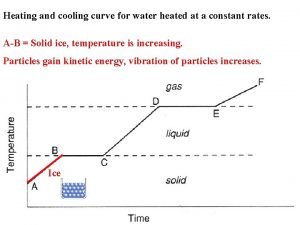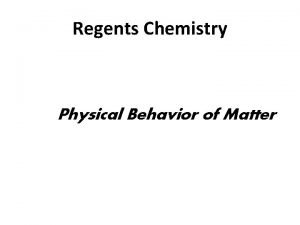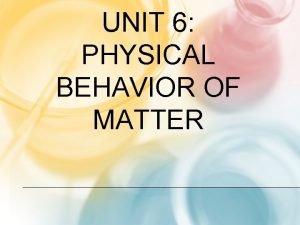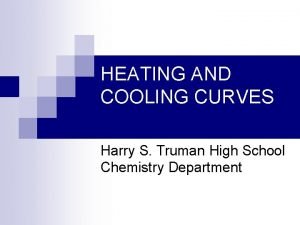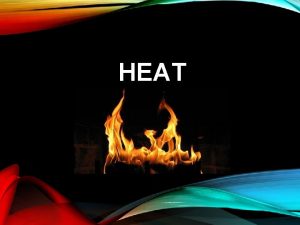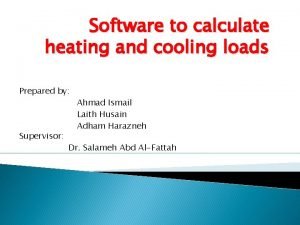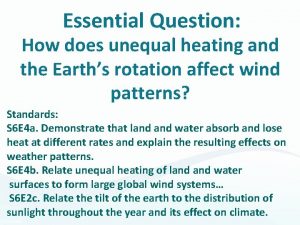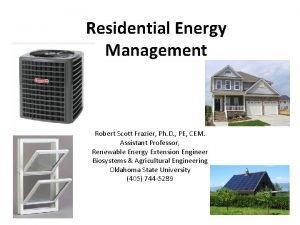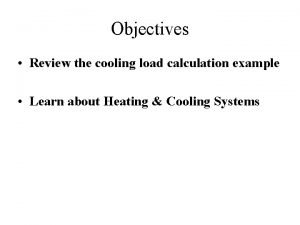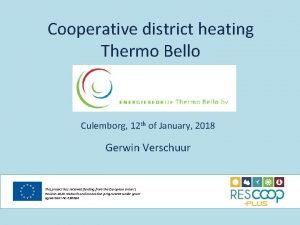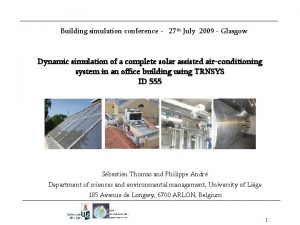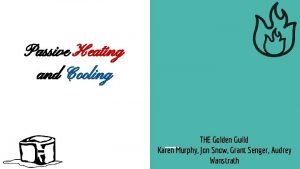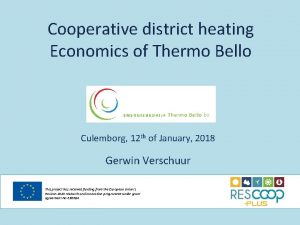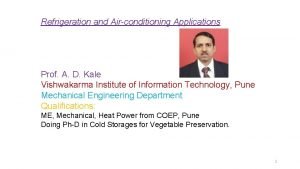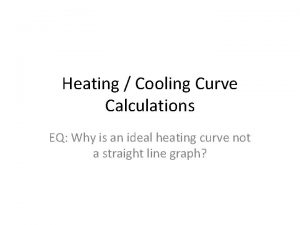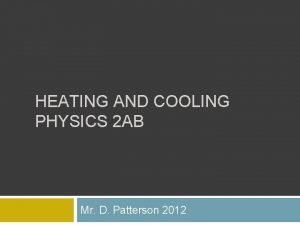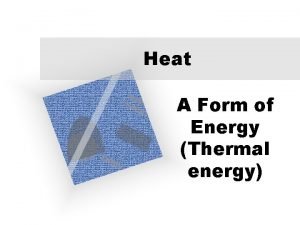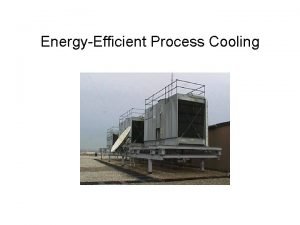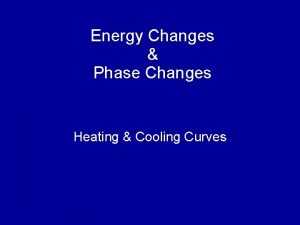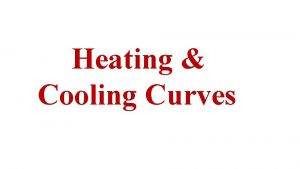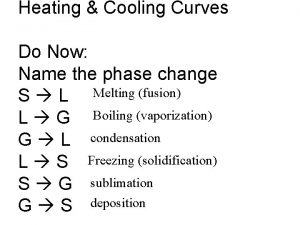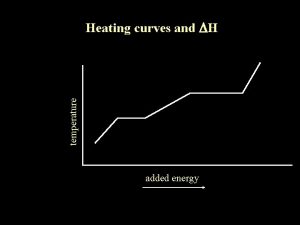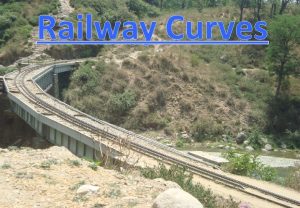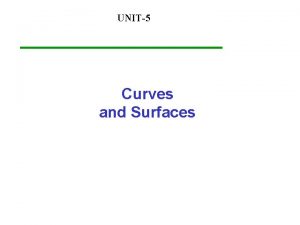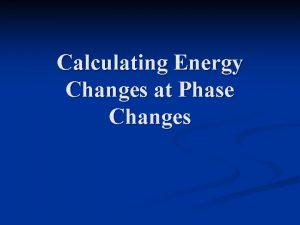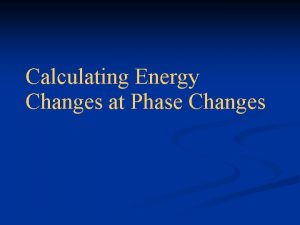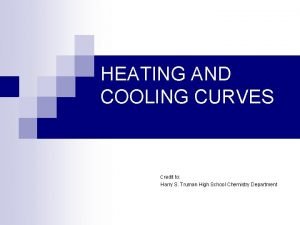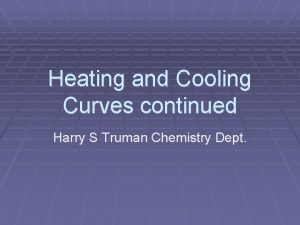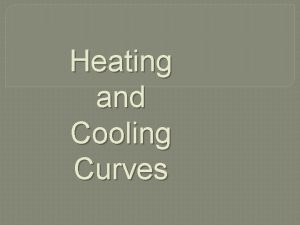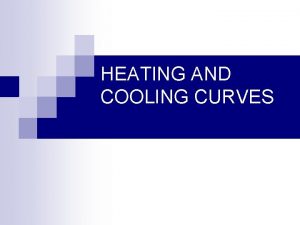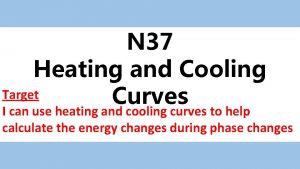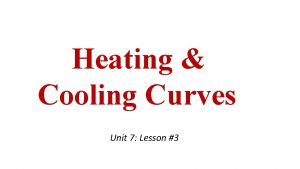Energy Changes Phase Changes Heating Cooling Curves It































- Slides: 31

Energy Changes & Phase Changes Heating & Cooling Curves

It takes energy to heat stuff up! • For a pure substance in a single phase, we can calculate how much using Q = m. C T. – Q = energy in Joules – m = mass in grams – C = specific heat capacity – T = change in temperature = Tf - Ti • On the other hand, when something cools down, energy is released!

Q = m. C T • C = specific heat capacity = amount of heat required to raise the temperature of 1 gram of a pure substance by 1 C. • C is a physical constant. It is unique for every pure substance. • Values of C are tabulated. • CH 2 O = 4. 2 J/g

Heat Flow: hot to cold Environment System – 1 phase

But what about phase changes? • Sometimes more than one phase of a substance is present. • For example, when melting ice, both liquid water and ice are present. • Furthermore, the temperature is constant, so T = 0, even though the beaker of ice water is absorbing heat from a hot plate.

All chemical & physical changes are accompanied by energy changes. • Phase changes are physical changes. • Sometimes energy is absorbed, sometimes energy is released. • The energy change for a given phase change can be measured or calculated.

What are 6 possible phase changes and their names?

Potential Energy • Energy of relative position. • Molecules are always attracted to one another. • You have to put energy into the system to pull molecules apart from one another. • So the farther apart they are, the higher their potential energy.

Melting Ice • Ice water on hot plate: ice is melting. • The ice is absorbing heat from the hot plate and using it for the phase change. • The temperature of ice-water mix is constant -- the heat energy from the hot plate is going into the phase change or potential energy of the system. • The heat energy is not going to the kinetic energy. Remember, temperature is …

Identify a phase change as endothermic or exothermic. Gas P. E. Liquid Solid Endothermic Exothermic Fusion Vaporization Sublimation Condensation Freezing Deposition

Heating & Cooling Curves • 1 way to investigate energy changes. • Measure temperature as a function of time at a constant heating or cooling rate.

Temperature I II Solid & Liquid K. E. ↔ K. E. P. E. ↔ Melt pt. III P. E. ↔ Time IV V Liquid & Gas Boil pt. K. E. ↔ K. E. P. E. ↔

Melting & Boiling Points • Plateaus = Phase changes = Potential energy changes. • Notice that as long as 2 phases are present, the temperature is constant. • Melting point, Boiling point. Tiger

What happens to the temperature as heat is added at the boiling point? • Nothing, until only 1 phase is present!

Heating Curve • Tiger Graphic

To analyze a heating/cooling curve: • Does the curve go uphill or downhill? • Label the phases present in each region. • Describe what happens to the K. E. in each region. • Describe what happens to the P. E. in each region. • Locate the melting point and boiling point.

Heating curve of H 2 O.

What is the melting point of this substance? The boiling point?

Experimental Approach The heating rate is 150 J/min. If the substance takes 4 minutes to melt, how much heat energy was used to melt it?

3 equations for Q • Q = m. C T • Q = m. Hf • Q = m. Hv • Have to figure out which one to use for a given problem. • Depends which section of heating curve. • Look for hints in the problem.

Temperature Q= m. Cs T Q= m. Hf Q= m. Cl T Time Q= m. Hv Q= m. Cg T

Q = m. C T: pure substance, single phase • Temperature changed • Temperature increased • Temperature decreased • Initial temperature • Start temperature • • Final temperature Ending temperature From ____ to ____ Water

Q = m. Hf : liquid and solid present • • • Ice Freezing Melting At 0 C (for H 2 O) At constant temperature

Heat of Fusion • Amount of energy required to change 1 gram of a pure substance from a solid to a liquid at its melting point. • Heat of Fusion = Hf = physical constant. • Hf for water = 333. 6 Joules per gram (Table B)


How much heat is absorbed when 10 grams of ice melts at 0 o. C? • Heat absorbed = mass of substance X heat of fusion of substance • Q = m. Hf = (10 g)(333. 6 J/g) = 3336 J • Where does that energy go? • Particles must overcome forces of attraction to move farther apart.

Q = m. Hv : liquid and gas present • • • Steam Boiling Condensation or Condensing At 100 C (for H 2 O) At constant temperature

Heat of Vaporization • Amount of energy required to convert 1 gram of a pure substance from a liquid to a gas at its boiling point. • Heat of vaporization = Hv = physical constant • Hv for water = 2259 J/g

How much energy does it take to vaporize 10 g of water? • Q = m. Hv • Q = (10 g)(2259 J/g) = 22590 J • It takes a lot more energy to go from liquid to gas than from solid to liquid. Why?

The particles are spreading out a lot more!

Heats of fusion & vaporization • Determined in calorimetry experiments.
 Heating cooling curve for water
Heating cooling curve for water Physical behavior of matter
Physical behavior of matter Physical behavior of matter heating and cooling curves
Physical behavior of matter heating and cooling curves Heating curve
Heating curve Fusion chemistry phase change
Fusion chemistry phase change Difference between induction heating and dielectric heating
Difference between induction heating and dielectric heating Heat curve labeled
Heat curve labeled Market practice definition
Market practice definition Air conditioning heat load calculation software
Air conditioning heat load calculation software Sea breeze
Sea breeze Frazier heating and cooling
Frazier heating and cooling Cooling load calculation sample problems
Cooling load calculation sample problems Thermo bello
Thermo bello H&c heating and cooling
H&c heating and cooling Karen heating and cooling
Karen heating and cooling Bello heating and cooling
Bello heating and cooling Kale heating and cooling
Kale heating and cooling Heating cooling curve equations
Heating cooling curve equations Sieb plumbing
Sieb plumbing Specific heat capacity
Specific heat capacity Heat energy formula
Heat energy formula Energy process cooling
Energy process cooling Normal phase vs reverse phase chromatography
Normal phase vs reverse phase chromatography Tswett pronunciation
Tswett pronunciation Mobile phase and stationary phase
Mobile phase and stationary phase Hplc definition
Hplc definition Normal phase vs reverse phase chromatography
Normal phase vs reverse phase chromatography Line vs phase voltage
Line vs phase voltage Detectors used in hplc
Detectors used in hplc In a triangle connected source feeding a y connected load
In a triangle connected source feeding a y connected load Broad phase vs narrow phase
Broad phase vs narrow phase All states of matter
All states of matter
